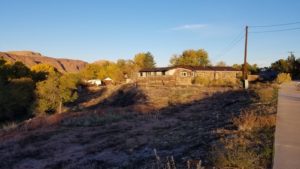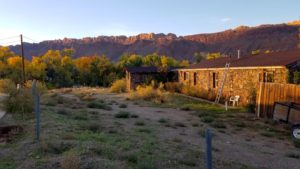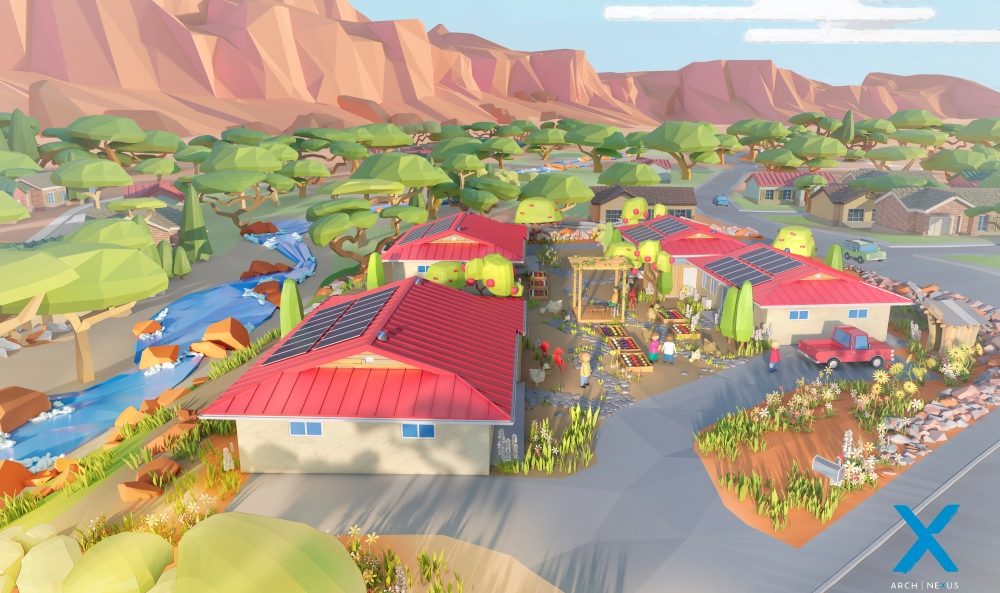Community Rebuilds and its partners at Architectural Nexus have officially registered to build the first fully certified Living Buildings in Utah.
 These homes, located in Moab, will confront challenges in economic and environmental sustainability by undertaking the Living Building Challenge (LBC). This rigorous building certification lobbies to change the narrative that people and buildings are separate from and harmful to the environment.
These homes, located in Moab, will confront challenges in economic and environmental sustainability by undertaking the Living Building Challenge (LBC). This rigorous building certification lobbies to change the narrative that people and buildings are separate from and harmful to the environment.
Instead, the LBC proves that buildings can and should be regenerative, self-sufficient, and have a positive impact on their surroundings, as opposed to “merely” reducing the negative impact, which is the goal of most sustainability initiatives.
These four homes have the potential to be the first to be fully LBC-certified homes for low-income residents. Affordability is key in sustainability and Community Rebuilds wants to prove that healthy, restorative buildings are for everyone. The challenge is improving upon the Community Rebuilds model by making energy-efficient straw bale homes more regenerative.
Living Buildings function as cleanly and efficiently as a flower, meaning the homes must be:
- Water Positive: only using water that is naturally available on site in a closed loop system, treating and managing all water on site without the use of chemicals;
- Energy Positive: generating all energy on site with renewable resources, using a low-embodied energy material pallet, and offsetting the carbon footprint of the building; and
- Materially Responsible: avoiding many of the conventional building materials that are toxic to people and the environment, reducing waste, and sourcing as locally and responsibly as possible.
 This is actually a redevelopment project, as the homes will be built on the site of the previous Community Rebuilds intern home. Deconstruction of the previous building began in the spring of 2019 with the intention of salvaging as much usable building material as possible. Reusing materials from this building and others has become a key strategy for the project.
This is actually a redevelopment project, as the homes will be built on the site of the previous Community Rebuilds intern home. Deconstruction of the previous building began in the spring of 2019 with the intention of salvaging as much usable building material as possible. Reusing materials from this building and others has become a key strategy for the project.
These materials, which would otherwise head to the landfill, lower the carbon and monetary cost of construction, and reduce the need to produce new materials. Community Rebuilds is currently accepting donated building materials from the community to incorporate into these homes.
While many Community Rebuilds homes already address energy efficiency and resilience, the non-profit builder is excited to take on the challenge of becoming water positive. Water is an extremely valuable resource everywhere, but particularly in arid Utah.
This project is helping to advocate for more sustainable practices in water management to key decision makers in the state. These homes will use rainwater for toilet flushing and all other water used in the home will be used to irrigate the landscape. By partnering with the Health Department, Community Rebuilds is paving a way for permitting residential composting toilets.
In addition to pursuing the LBC, Community Rebuilds certified the first net zero energy builds in Utah through the International Living Future Institute. Zach Ahrens’ home, built in 2015, was certified earlier this year for generating more energy than it uses. They hope that this inspires other builders in the region to incorporate renewable energy and energy efficient building techniques as well.
Construction on the first two homes of the LBC project is expected to begin in the summer of 2019. Updates on the project will be posted on the Community Rebuilds’ website and blog. The staff at Community Rebuilds says they are excited to journey further into regenerative design through the LBC and continue creating new realities for affordable homes.
Project sponsors include REG Engineering, Little Salt Wash Straw, and Gardner Energy. Community Rebuilds is an equal housing provider through USDA Rural Development.
All images are courtesy of Arch Nexus and Community Rebuilds.
Learn more about the Living Building Challenge.

